1721 FRANCE King LOUIS XV Lighthouse at Coroquna Silver French Medal NGC i83748
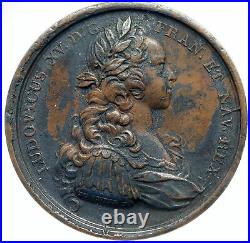
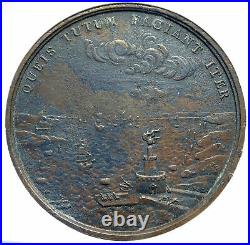
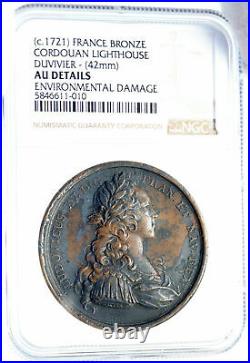
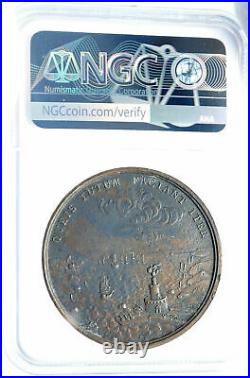
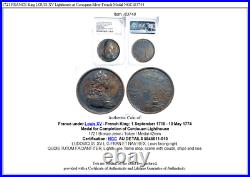

Item: i83748 Authentic Coin of. French King: 1 September 1715 - 10 May 1774 Medal for Completion of Cordouan Lighthouse 1721 Bronze Jeton / Token / Medal 42mm Certification: NGC. QUDIS TUTUM FACIANT ITER, Lighthouse, flame atop, scene with clouds, ships and sea. Cordouan lighthouse is an active lighthouse located 7 kilometres (4.3 miles) at sea, near the mouth of the Gironde estuary in France.
At a height of 223 feet (68 m), it is the tenth-tallest "traditional lighthouse" in the world. The Tour de Cordouan, the'Patriarch of Lighthouses', is by far the oldest lighthouse in France. It was designed by leading Paris architect Louis de Foix, and is something of a Renaissance masterpiece, an amalgam of royal palace, cathedral and fort. Started in 1584 and finished in 1611, it still stands today.Small beacon towers had existed on the islet since 880, but the first proper structure was implemented by Edward, the Black Prince, as Guienne was then an English province. It was 48 feet (15 m) high, with a platform on top where a wood fire could be kept burning, and manned by a religious hermit. Passing ships paid two groats to pass - the first known instance of lighthouse dues. In addition to the tower, a small chapel was built on the islet. By the second half of the 16th century the tower had fallen into disrepair and the hazard to navigation threatened the Bordeaux wine trade.
This led to the construction of the current Tour de Cordouan. De Foix first built a round base 135 feet (41 m) in diameter and 8 feet (2.4 m) high to take the onslaught of the waves.
Within it was a 20-square-foot 1.9 m. Cavity for storing water and other supplies. Above it were constructed four storeys of diminishing size. The ground floor consisted of a circular tower 50 feet (15 m) in diameter, with apartments for four keepers around its inner wall. In the centre was a richly decorated entrance hall 22 square feet 2.0 m. And 20 feet (6.1 m) high.The second storey was the King's Apartment, consisting of a drawing room, anteroom and a number of closets. The third storey was a chapel with a domed roof notable for the beauty of its mosaic.
Above this was secondary lantern, and above that the Lantern itself. This was 162 feet (49 m) above the sea and visible 5-6 miles away, the original light being provided by burning oak chips in a metal container. Throughout the building, de Foix took as much trouble with the decor as with the durability of the building, and on every floor was a profusion of gilt, carved work, elegantly arched doorways and statuary. The first parabolic lamps were added in 1782, but the lighthouse at the time was in very poor condition. Sailors also criticized the lack of height of the light. They were carried out from 1782 to 1789 by the engineer Joseph Teulère who suggested enhancing the 30-metre tower, retaining the ground floor and two floors, in the Louis XVI style, the simplicity of which contrasted with the wealth of the lower floors, which retained their Renaissance decoration. In 1790, after the lighthouse was raised 60 meters above the highest tides, Teulère devised the first turning lighting dish. It consisted of Argand lamps turned by a machine built by a watchmaker in Dieppe. The fuel was a mixture of whale, olive and rapeseed oil. The first Fresnel lens rotating system, the invention of Augustin-Jean Fresnel, was installed in Cordouan in 1823. Three concentric lamp wicks, supplied with rapeseed oil by means of a suction and force pump, were placed in the focal plane of the apparatus. It was restored in 1855 and made a historical monument in 1862, at the same time as Notre-Dame de Paris.The original Fresnel lens was replaced by the present lens in 1854. The light was converted to petroleum gas in 1907 and to electricity in 1948, when a 6,000W lamp was used. The lamp was replaced by a 450W xenon lamp in 1984 but this was not successful and a halogen lamp was installed three years later. It was fully automated in 2006, although lighthouse keepers are still employed.
Indeed, unlike in other lighthouses, maintaining continued keeping in Cordouan was deemed necessary to preserve this especially old and historic lighthouse, as well as to show visitors around. The last two State-formed, "traditional" keepers left in 2012 and were replaced by members of SMIDDEST, a local association.
Cordouan is therefore the last inhabited lighthouse in France since the Cap Fréhel lighthouse saw its last keeper depart in August 2019. Louis XV (15 February 1710 - 10 May 1774), known as Louis the Beloved , was a monarch of the House of Bourbon who ruled as King of France from 1 September 1715 until his death in 1774. He succeeded his great-grandfather Louis XIV at the age of five. Until he reached maturity (then defined as his 13th birthday) on 15 February 1723, the kingdom was ruled by Philippe II, Duke of Orleans, as Regent of France. Cardinal Fleury was his chief minister from 1726 until the Cardinal's death in 1743, at which time the young king took sole control of the kingdom.
He ceded New France in North America to Spain and Great Britain at the conclusion of the disastrous Seven Years' War in 1763. He incorporated the territories of the Duchy of Lorraine and the Corsican Republic into the Kingdom of France. He was succeeded in 1774 by his grandson Louis XVI, who was executed by guillotine during the French Revolution.
Two of his other grandsons, Louis XVIII and Charles X, occupied the throne of France after the fall of Napoleon I. Historians generally give his reign very low marks, especially as wars drained the treasury and set the stage for the governmental collapse and French Revolution in the 1780s.
Jetons or jettons are tokens or coin-like medals produced across Europe from the 13th through the 17th centuries. They were produced as counters for use in calculation on a counting board, a lined board similar to an abacus. Thousands of different jetons exist, mostly of religious and educational designs, as well as portraits, the last of which most resemble coinage, somewhat similar to modern, non-circulation commemorative coins.
The spelling "jeton" is from the French; the English spell it "jetton". France , officially the French Republic (French: République française), is a sovereign state comprising territory in western Europe and several overseas regions and territories. The European part of France, called Metropolitan France, extends from the Mediterranean Sea to the English Channel and the North Sea, and from the Rhine to the Atlantic Ocean.
France spans 640,679 square kilometres (247,368 sq mi) and has a total population of 67 million. It is a unitary semi-presidential republic with the capital in Paris, the country's largest city and main cultural and commercial centre.The Constitution of France establishes the state as secular and democratic, with its sovereignty derived from the people. During the Iron Age, what is now Metropolitan France was inhabited by the Gauls, a Celtic people. The Gauls were conquered in 51 BC by the Roman Empire, which held Gaul until 486. The Gallo-Romans faced raids and migration from the Germanic Franks, who dominated the region for hundreds of years, eventually creating the medieval Kingdom of France.
France emerged as a major European power in the Late Middle Ages, with its victory in the Hundred Years' War (1337 to 1453) strengthening French state-building and paving the way for a future centralized absolute monarchy. During the Renaissance, France experienced a vast cultural development and established the beginning of a global colonial empire. The 16th century was dominated by religious civil wars between Catholics and Protestants (Huguenots).
France became Europe's dominant cultural, political, and military power under Louis XIV. French philosophers played a key role in the Age of Enlightenment during the 18th century. In 1778, France became the first and the main ally of the new United States in the American Revolutionary War. In the late 18th century, the absolute monarchy was overthrown in the French Revolution. Among its legacies was the Declaration of the Rights of Man and of the Citizen , one of the earliest documents on human rights, which expresses the nation's ideals to this day.
France became one of modern history's earliest republics until Napoleon took power and launched the First French Empire in 1804. Fighting against a complex set of coalitions during the Napoleonic Wars, he dominated European affairs for over a decade and had a long-lasting impact on Western culture. Following the collapse of the Empire, France endured a tumultuous succession of governments: the monarchy was restored, it was replaced in 1830 by a constitutional monarchy, then briefly by a Second Republic, and then by a Second Empire, until a more lasting French Third Republic was established in 1870.
By the 1905 law, France adopted a strict form of secularism, called laïcité , which has become an important federative principle in the modern French society. France reached its territorial height during the 19th and early 20th centuries, when it ultimately possessed the second-largest colonial empire in the world. In World War I, France was one of the main winners as part of the Triple Entente alliance fighting against the Central Powers. France was also one of the Allied Powers in World War II, but came under occupation by the Axis Powers in 1940.
Following liberation in 1944, a Fourth Republic was established and later dissolved in the course of the Algerian War. The Fifth Republic, led by Charles de Gaulle, was formed in 1958 and remains to this day. Following World War II, most of the empire became decolonized. Throughout its long history, France has been a leading global center of culture, making significant contributions to art, science, and philosophy. It hosts Europe's third-largest number of cultural UNESCO World Heritage Sites (after Italy and Spain) and receives around 83 million foreign tourists annually, the most of any country in the world. France remains a great power with significant cultural, economic, military, and political influence. It is a developed country with the world's sixth-largest economy by nominal GDP and eight-largest by purchasing power parity. According to Credit Suisse , France is the fourth wealthiest nation in the world in terms of aggregate household wealth. It also possesses the world's second-largest exclusive economic zone (EEZ), covering 11,035,000 square kilometres (4,261,000 sq mi).French citizens enjoy a high standard of living, and the country performs well in international rankings of education, health care, life expectancy, civil liberties, and human development. France is a founding member of the United Nations, where it serves as one of the five permanent members of the UN Security Council.
It is a member of the Group of 7, North Atlantic Treaty Organization (NATO), Organisation for Economic Co-operation and Development (OECD), the World Trade Organization (WTO), and La Francophonie. France is a founding and leading member state of the European Union (EU). World-renowned expert numismatist, enthusiast, author and dealer in authentic ancient Greek, ancient Roman, ancient Byzantine, world coins & more. Ilya Zlobin is an independent individual who has a passion for coin collecting, research and understanding the importance of the historical context and significance all coins and objects represent.
Send me a message about this and I can update your invoice should you want this method. Getting your order to you, quickly and securely is a top priority and is taken seriously here. Great care is taken in packaging and mailing every item securely and quickly.What is a certificate of authenticity and what guarantees do you give that the item is authentic? You will be very happy with what you get with the COA; a professional presentation of the coin, with all of the relevant information and a picture of the coin you saw in the listing.
Additionally, the coin is inside it's own protective coin flip (holder), with a 2x2 inch description of the coin matching the individual number on the COA. Whether your goal is to collect or give the item as a gift, coins presented like this could be more prized and valued higher than items that were not given such care and attention to. When should I leave feedback? Please don't leave any negative feedbacks, as it happens sometimes that people rush to leave feedback before letting sufficient time for their order to arrive. The matter of fact is that any issues can be resolved, as reputation is most important to me. My goal is to provide superior products and quality of service. How and where do I learn more about collecting ancient coins? Visit the Guide on How to Use My Store.For on an overview about using my store, with additional information and links to all other parts of my store which may include educational information on topics you are looking for. The item "1721 FRANCE King LOUIS XV Lighthouse at Coroquna Silver French Medal NGC i83748" is in sale since Friday, May 1, 2020.
This item is in the category "Coins & Paper Money\Exonumia\Medals". The seller is "highrating_lowprice" and is located in Rego Park, New York. This item can be shipped worldwide.
- Country/Region of Manufacture: France
- Composition: Silver
- Denomination: Denomination_in_description
- Year: Year_in_description
